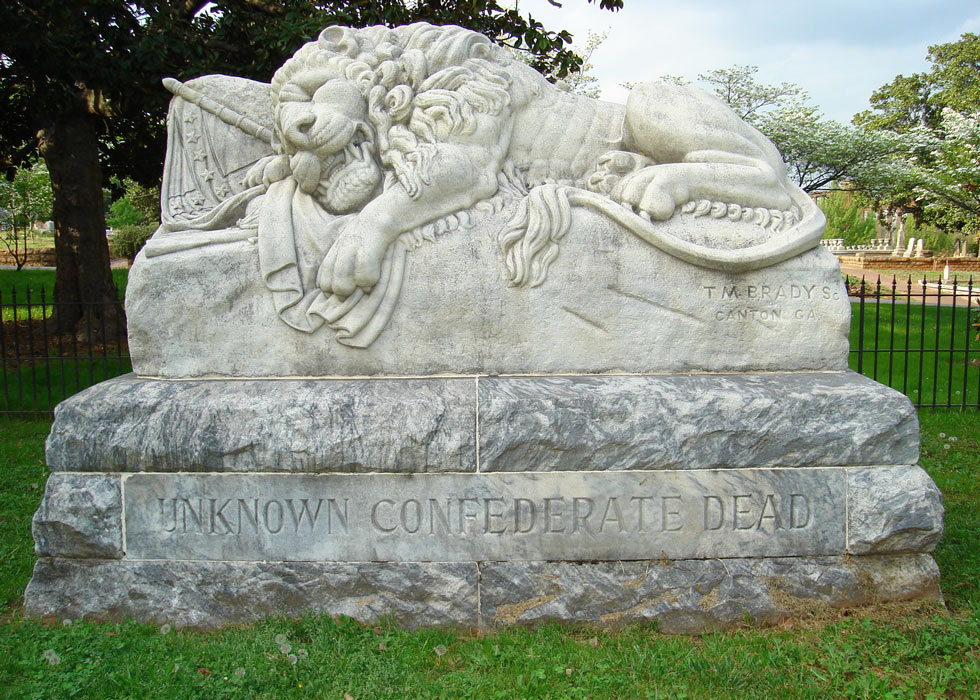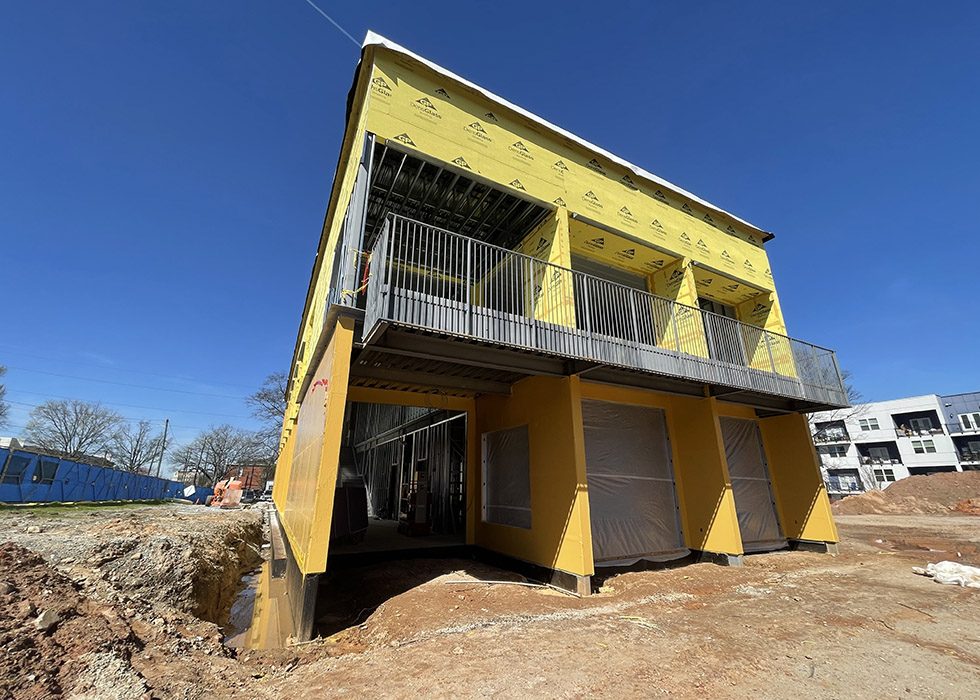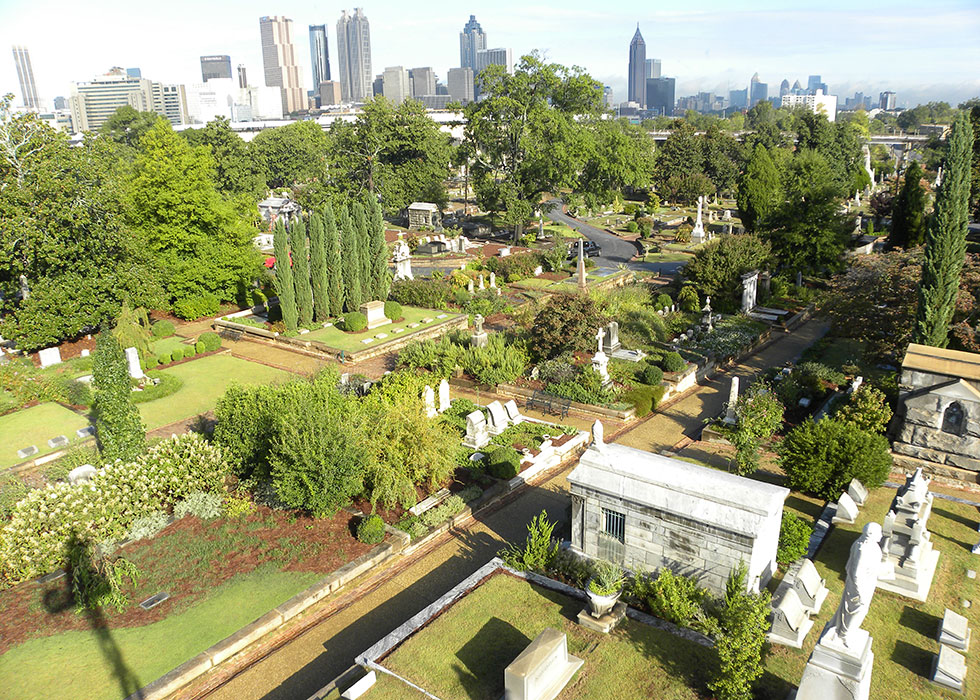
Frequently Asked Questions about Confederate Monuments and Vandalism at Oakland
Early Sunday morning, February 28, unknown individuals vandalized the Lion of Atlanta statue and the Confederate Obelisk at historic Oakland Cemetery. This is not the first time vandalism has taken place in the Civil War section of the cemetery. In an effort to address the many questions we receive about the monuments—particularly when an act of vandalism has taken place—we have compiled this list of frequently asked questions and answers to fully explain the current status of the monuments, the process for when vandalism occurs, and our approach to interpreting their historical and contemporary meanings.
Who owns the Lion of Atlanta and the Confederate Obelisk?
The Obelisk is owned and maintained by the city of Atlanta’s Department of Parks and Recreation and the Lion of Atlanta is part of the City of Atlanta’s art collection under the care of the Mayor’s Office of Cultural Affairs. While Historic Oakland Foundation is a private non-profit whose mission is to preserve, restore, enhance, and share Oakland Cemetery in partnership with the City of Atlanta, the cemetery is a public City of Atlanta park and is ultimately under the care and jurisdiction of the City of Atlanta. The Confederate Burial Grounds and its corresponding monuments are excluded from those sections overseen by the Historic Oakland Foundation.
Who is responsible for the cleaning of the monuments?
The City of Atlanta oversees all upkeep of these monuments and carries out any remediation if the monuments are vandalized. As matter of public safety, the Department of Parks and Recreation, which is responsible for the Obelisk, removes vandalism containing profanity in city parks when it is brought to their attention. The Lion of Atlanta is part of the City of Atlanta’s art collection, and therefore vandalism to that monument is handled by the Mayor’s Office of Cultural Affairs.
Why can’t I help clean the monuments?
Removing paint from granite, marble, and brick surfaces requires an experienced conservation professional along with tools, equipment, and specialized chemicals that will remove various types of paint on the surface while preserving the underlying historic materials. For this reason, it is important that unauthorized visitors do not try to assist in removing the paint or otherwise attempt to remediate the damage.
What security measures are in place at the cemetery?
As part of the Memorandum of Understanding that governs and guides the relationship and division of responsibilities between Historic Oakland Foundation (HOF) and the City of Atlanta Department of Parks and Recreation, the security of Oakland Cemetery is within the purview of the Department of Parks and Recreation. Oakland Cemetery has a number of security cameras and motion-sensor activated security floodlights, especially in low-trafficked areas of the Cemetery. The Cemetery is also patrolled overnight by a security guard, contracted by the city. In the 2017 Historic Oakland Foundation Master Plan, HOF’s board of trustees committed to supporting our partners in the City of Atlanta with Oakland’s constantly evolving security infrastructure.
Why are Confederate monuments so controversial today?
While early Confederate monuments may have been installed sincerely as a way to mourn lost loved ones, the vast majority of Confederate monuments were installed during the period in which Jim Crow laws were enacted by white politicians to discriminate against African Americans, from the end of Reconstruction to the mid-20th century. These laws codified racial segregation and were informed by the continued presence of white supremacist thought in the United States following the end of the Civil War (1861-1865). For many, these monuments represent Lost Cause Ideology, which ignores slavery as the main cause of the Civil War and commemorates a racial hierarchy where African Americans were subservient to whites. The Lost Cause remained a powerful influence in the South for generations, and is still embedded in some public discourse about the Civil War.
In Georgia, the contemporary fate of confederate monuments has been an ongoing contentious political issue. Georgia state law currently prohibits the removal of Confederate monuments, though individual municipalities have circumvented this law by accepting the fines imposed on them by the state as part of the removal cost.
How has the City of Atlanta approached the controversy surrounding Confederate monuments?
Following the appalling events of Charlottesville, Virginia, in 2017, the Atlanta City Council created a committee to assess city-owned Confederate monuments and street names. The Advisory Committee on City of Atlanta Street Names and Monuments Associated with the Confederacy recommended removing two Confederate monuments in Atlanta and renaming streets associated with the Confederacy and its leaders. Several streets were thus renamed. However, as Georgia state law prohibits removing or obscuring existing monuments, elected officials determined that the installation of interpretive panels at monuments, including the two at Oakland, provided an acceptable alternative.
How does Historic Oakland Foundation interpret the Confederate monuments at Oakland?
Historic Oakland Foundation, the Atlanta History Center, and the City of Atlanta collaborated to add interpretive panels at the city’s Confederate monuments. These contextual panels provide information about the monuments, the motivations behind their construction, and their social impact in the past and present. The historical panels also address the Lost Cause interpretation of the Civil War and acknowledge the struggles of African Americans experiencing and fighting against slavery and segregation. Three new interpretive panels were installed in Oakland’s Civil War Section in August 2019.
Why do the contextual panels say this?
The Confederate Obelisk was unveiled in 1874. As it does not delineate the location of any grave, it is a monument and not a grave marker. From its installation, the Obelisk was a gathering place for Confederate Memorial Day celebrations in Atlanta. These celebrations and the individuals who fought to vindicate the Confederacy helped to perpetuate Lost Cause Ideology in the South and beyond.
Though the Lion of Atlanta was installed to mark the graves of unknown Confederate dead, both the timing of its installation and the themes found in its design mean that it also serves as a monument to the Confederacy. The Lion was erected in 1894 when white Southerners were well into the process of dismantling Reconstruction-era integration laws. It was modeled after the famous Lion of Lucerne monument, except that the mortally wounded lion protects a Confederate flag instead of the shields of the French monarchy and the Swiss coat of arms. In its dedication ceremony, speakers declared that the “sacred” cause for which the soldiers fought was that of “righteousness and truth,” and that the war was fought over states’ rights to secede (as opposed to being fought over the right to maintain racial hierarchies, as detailed in Confederate Vice President Alexander Stephens’ infamous 1862 “Cornerstone Speech”). Speakers described the outcome of the Civil War as “disastrous peace,” condemned the north “with its growing jealousy of power…its fanatical antagonism of slavery,” denied that the Confederacy was guilty of treason, and proclaimed that “the principles for which you fought and your comrades fell are not ‘lost’ and can never die. They stand today with renewed strength.”
Do the meanings of monuments change or stay the same?
The meanings of all historical monuments, including Confederate monuments, reflect current times and are not static or frozen in the moment of their erection. The vandalism of Confederate monuments is part of the accrued history of those objects. Historic Oakland Foundation is dedicated to interpreting every era of Oakland Cemetery. Our public interpretation of the Lion of Atlanta and Confederate Obelisk presents the full history and, out of a necessity to provide ethical, equitable, and accurate public interpretation, includes a discussion of how meanings and societal values can change between the time in which a monument is installed and the present day.
Dialogue and debate are important for civil discourse as the city continues to wrestle with its history and its history’s meaning. This is a vital, ongoing process for a vibrant civil society; it helps form a deeper, richer understanding of who we are and the values we decide to uplift or de-emphasize. Historic Oakland Foundation wants the families of those buried at Oakland and visitors to Oakland to feel welcome and safe. We are committed to providing a space for our city to hold difficult conversations as we work collectively to form a more beloved community.



